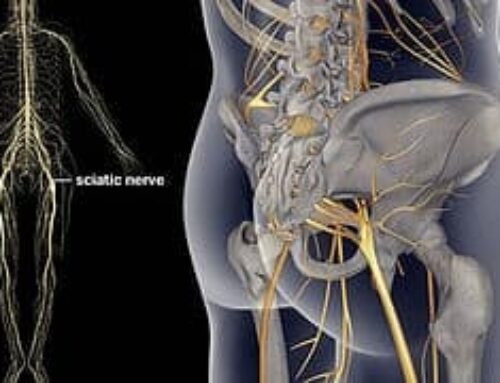One of the most common questions that people have about sciatica nerve pain is how to find the best doctor for sciatica.
Now, if you look online, the sources are going to say neurologist, orthopedic surgeon, physical therapist. But before you get to picking your doctor, here are the hallmark things that you need to know when it comes to sciatica.
Causes of Sciatica
First of all, it can come from a variety of different sources. So sciatica, in the most general sense, means that your sciatic nerve somewhere along the route is being pinched on and it’s causing nerve pain down into your hips down into your leg. It could be the front of the leg, the back of the leg, or a variety of different pain representation patterns.
But what’s important to know is there are a few different sources that could actually pinch the sciatic nerve. The sciatic nerve has a bunch of nerve roots. So if you imagine a nerve root as an on-ramp to a freeway, and then the freeway itself is the sciatic nerve, we have to know if it’s coming from a nerve root, which is one of those on-ramps or if it’s coming from the big nerve being pinched.
If a nerve root (one of the on-ramps) is being pinched, a disc bulge could be causing the pain. Disc bulges could be caused by joints that aren’t moving appropriately, or it could be muscles that are compressing the area too much.
Not all disc bulges cause sciatic nerve pain, though, and a lot of the time a disc bulge can be present and be putting pressure on the sciatic nerve but not actually be causing the pain. Unfortunately, many people jump to MRIs to identify where the nerve is being pinched and then will get surgery or injections based on that imaging. But after the surgery, the pain doesn’t go away because the imagery that they did lead the doctors to jump to conclusions and misdiagnose the actual cause.
That is a typical presentation of someone who might have positive imaging. But the things that show up on imaging are not always the thing that is actually pinching on that sciatic nerve. So identifying which of the five or six on-ramps is causing the traffic backup, we’ll say, is one way to determine where the sciatica is coming from.
If it’s not coming from a nerve root, it can actually be because there’s a problem on the freeway itself. This is where a lot of different muscles start to pinch on your sciatic nerve, whether it’s your piriformis, or your hamstring, or other muscles further down the leg. These muscles pull on the pieces of the nerve that split off as it goes into your lower foot.
Which Doctor Can Diagnose Sciatica
So the first step to figuring out who to see for sciatica is figuring out who can best tell you what is actually causing it. This is most effectively and accurately done through a series of movement tests to identify where it is not coming from. This process of elimination is how you can identify where it is coming from.
The best doctor for sciatica that will be able to tell you what is actually causing your pain is a doctor of physical therapy. A specialized PT can identify the root cause based on a series of movement tests and examinations.
Which Doctor Treats Sciatica At The Root Cause?
At the end of the day, if it is a problem at one of the “on-ramps,” caused by a herniated disk in the back or by a static condition where the space between the bones actually closes, the case might need surgery.
However, the vast majority of sciatica cases, especially when they first start, are because of muscular dysfunction. So muscles in and around the area are causing joint compression because they’re not behaving appropriately and are compressing the sciatic nerve.
How an orthopedic or neurosurgeon treats sciatica
An orthopedic is generally going to either look at imaging to see if they can find what’s causing the issue, and then a few different methods can be tried.
They might prescribe several different anti-inflammatory measures which can include cortisone injections, epidurals, or steroids. If they’re able to identify where the nerve issue is coming from by doing a couple injections into the back and consistently showing a repeated result where that inflammation does decrease, then they know where they need to put an epidural.
However, what a lot of patients end up experiencing is that maybe an injection works the first time, then it doesn’t work the second time, and then they get told that they need some sort of surgical intervention. And so that’s the last step.
Most orthros don’t even want to go there, but after repeatedly referring out to unspecialized physical therapists who don’t return results, they feel that surgery is the only option left.
For severe disc herniations, a surgeon will need to go in and surgically clean up the disc herniation, which would be necessary in those more severe cases.
If there’s stenosis, you might be looking at a laminectomy, or what’s called a foraminotomy, where they go in and they take off the pieces of the bone that are impinging on the nerve. The way a neurosurgeon might treat sciatica is very similar to that.
How Physical Therapists Treat Sciatica
First, a good physical therapist who is specialized in finding and treating the root cause of dysfunction is going to be well versed in figuring out where that nerve issue is actually coming from, whether it’s from a nerve root, or the sciatic nerve. They’re going to do this based on a series of tests and measures that tell us what muscles might be impinging on it.
A lot of times, this can be the piriformis, it can be the hamstrings, it can be the SI joint, it could be a disc, or the joint spaces in the back are a little bit compressed and pinching down on the nerve.
Next, a good physical therapist is going to figure out what patterns the body has adopted that are causing the dysfunction. This is where the root cause comes in. We have two different diagnoses.
In our clinic, The Doctors of Physical Therapy in Scottsdale, our diagnoses are first, what is causing that nerve pain (disc, joint, or muscle)? And then we find the ROOT CAUSE by asking what is the cause of that first diagnosis (patterns in the brain, other muscles not working)?
We look for the movement patterns that are causing the pressure. The nerve pain is really the symptom, and the root cause is something different. Oftentimes, it’s that the brain is calling on the wrong muscles to do certain movements, which is then causing overuse of those muscles. That over use then causes impingement on the nerves or joints that then cause sciatica pain.
A specialized doctor of physical therapy will be able to guide their clients through a series of exercises and movements that first realign the body, and then retrain the brain how to use the correct muscles to achieve movement. From here, your doctor will work with you to build up and strengthen those muscles that have atrophied after months or years of neglect from the brain so that they have the power to take up their jobs again.
This is important because your fatigued, overused muscles that are clamping down on the nerves won’t be able to relax and give those nerves the breathing room they need until the correct muscles a) know how to do their jobs, and b) have the strength to perform them reliably without slipping back into old habits.
If you’re looking for a lasting solution to sciatica, that doesn’t involve needing to take pills or having surgery, you may qualify for a complimentary discovery visit with one of our specialists who will help you diagnose the root cause, and understand how to fix it. To request a discovery visit, click the button below and fill out the form on the next page.
Once you have filled out the form requesting your discovery visit, you may also download our guide which has tips to start getting relief fast. Click the button below to download our sciatica guide to start getting relief today.







